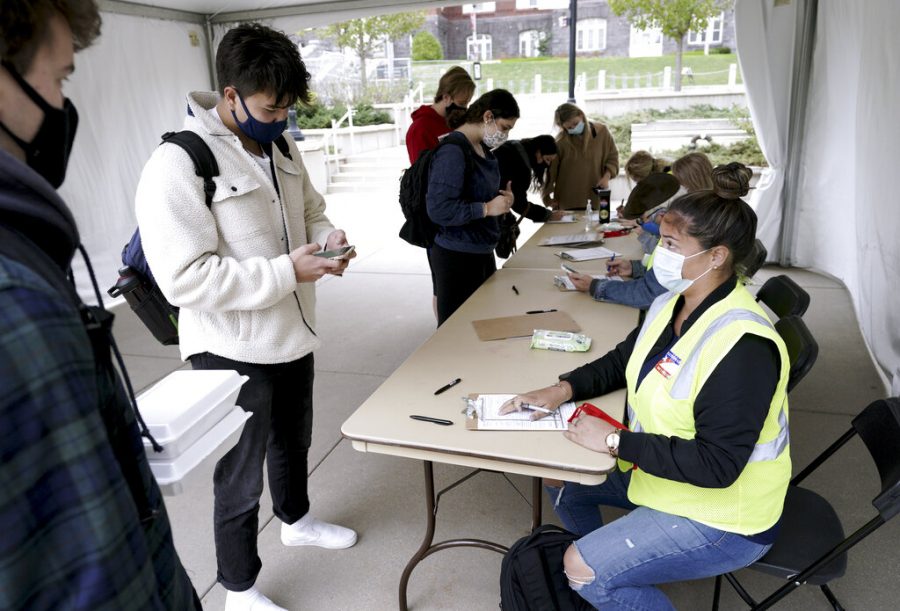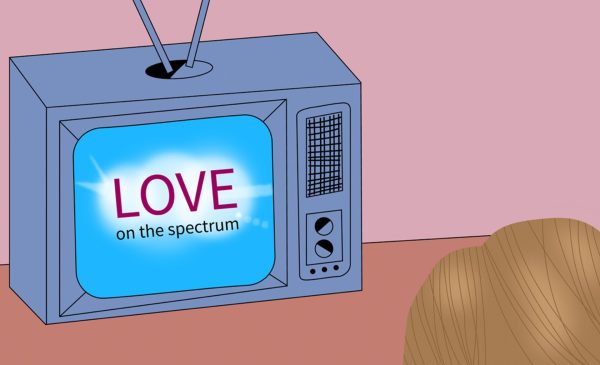Young voters increased turnout by 11 points in 2020 election
FILE-Elizabeth Quirmbach, right, registers Ayuka Sinanoglu, center, a Sophomore at the UW on Wednesday, Oct. 19, 2020 outside of the UW Memorial Union in Madison, Wis. A small but steady stream of masked UW-Madison students stopped by voter registration tables outside the unions last week to perform their civic duty. Madison City Clerk’s office employees helped them through the paperwork, sanitized their used pens and talked among themselves as they waited for the next students to filter into the fairly empty tents.(Steve Apps/Wisconsin State Journal via AP)
Despite worries that the pandemic would hinder access to polls, the 2020 election had the largest increase in voter turnout between presidential elections on record. In the months following the election, more than 350 voter suppression bills have been introduced nationwide. These bills, which significantly restrict mail-in voting and absentee ballots, are especially impactful for college students.
Young voters, ages 18-29, saw an 11-point increase in voter turnout from 2016, according to a recent study by Tufts University. According to the study, an estimated 50 percent of young people voted in the last election.
Campus Vote Project, a nonpartisan initiative created by the Fair Elections Center, aims to help college campuses distribute information about voting and create resources for students to further engage in politics.
Mike Burns, national director of Campus Vote Project, commented on the recent Tufts study in an email saying that the subsequent efforts to suppress voting directly impacts college students who should be celebrated instead of dissuaded from voting.
“This year marks the 50th anniversary of the ratification of the 26th Amendment, which expanded voting rights to youth over the age of 18,” Burns said in a statement. “Instead of celebrating the progress made in youth voter turnout over the course of the last half century, an alarming number of lawmakers are taking steps backwards.”
The implementation of these bills would be dangerous for college students who are still getting used to the voting process.
“Over 350 voter suppression bills have been introduced in state legislatures since January, having a particularly detrimental impact on students, who face unique barriers to voting due to frequent moves, postal access, academic and work schedules, and general newness and unfamiliarity with the registration and voting process,” Burns added.
Gabriel Smith, a Campus Vote Project democracy fellow in Florida, said that one of the factors he thought contributed to the increase in voter turnout was the voter mobilization efforts from various campus groups leading up to the election.
“And beyond that, I think a lot of people genuinely believed that the world was ending in 2020 because everything seemed so unprecedented and, you know, urgency works in getting people out there,” Smith said.
As voter suppression bills continue to raise a level of uncertainty in state election laws, President Joe Biden’s For the People Act may regulate some of these imbalances. The legislation has been passed in the House and still awaits debate in the Senate.
“This bill would standardize some election laws across the country and nationally establish: automatic voter registration (AVR), online voter registration (OVR), same-day or Election-Day registration (SDR), early voting, no-excuse absentee voting, pre-registration and requirements for voter registration programming in high schools,” the analysis of the Tufts study reads.
Though the legislation would standardize these policies nationwide, some states have already implemented most of these provisions. The Tufts study looked at states that have implemented these policies prior to the 2020 election and found that states that had four or more of these provisions had a combined youth turnout rate of 53 percent, compared to a 43 percent turnout from states with fewer than four policies.
If Biden’s For the People Act is signed into law, voter access and turnout rates would likely continue to increase. The study also found that vote-by-mail, which was not included in the legislation, was essential in assessing youth voter turnout. In states that automatically mailed ballots to voters, youth voter turnout was the highest at 57 percent and had the largest increases from 2016.
Katrina Phidd, the communications and digital strategy manager at Chicago Votes, said that increased youth voter turnout may be attributed to a hyper-awareness of the underlying issues in the country. Phidd points to a growing awareness of racial injustice, former President Donald Trump’s presidency and newfound recognition of the fragility of our social safety nets.
“It was kind of a period where young people were extremely aware of everything kind of going on in the world and voting is one way to react to everything,” Phidd said.
“Illinois is a pretty good state in terms of legislation that has been passed to increase voter access,” she added.
Illinois’ current voter registration laws allow for same-day registration, grace period voting and early voting. The election laws in place in Illinois are already similar to some of the policies in the For the People Act, but the passage of the legislation would standardize these procedures across the country. These laws expand accessibility for all voter demographics, but especially young people, who have seen an increase in voter turnout in recent years.












